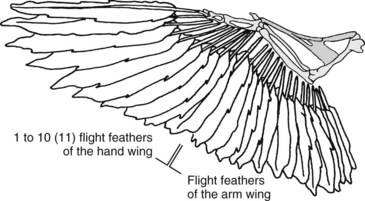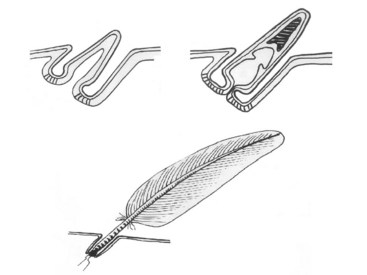Chapter 36 Feather Follicle Extirpation
Operative Techniques to Prevent Zoo Birds from Flying
However, the method of feather follicle extirpation could be applied to certain bird species without inappropriately influencing their normal behavior because swimming, diving, walking, eating, and maintaining balance during copulation are still possible. Obviously, the problem of maintaining balance is not as challenging for follicle-extirpated birds as it is, for example, for pinioned birds9 (Box 36-1).
BOX 36-1 Methods to Prevent Birds from Flying2,4-6,9,12-17
Historical Methods
As Acceptable Methods May be Defined
Anatomy
The skeleton of the wing consists of the humerus, ulna, radius, ossa carpi, and ossa metacarpalia (carpometacarpus) plus three fingers (phalanx proximalis minoris, phalanx proximalis digiti majoris, phalanx distalis digiti majoris; Fig. 36-1). The thumb phalanx, digiti alularis, is located at the os metacarpale majus.
Feathers
The pinion is a contour feather with a hollow shaft and a vane. The shaft consists of the big shaft (rhachis) and the calamus. The vane has plenty of rigid filaments (barbae) in a fan-shaped position. Those carry additional finer filaments (barbulae), which are interconnected with little hooks (hamulus). The umbilicus proximalis is situated at the end of the quill (Fig. 36-2).1,10
Feather Follicle
At the point of the calamus is a circular opening, the lower navel umbilicus proximalis inferior, where the corium reaches into the calamus and forms the corium papilla, covered by epidermal cells. This is the area of transition from the live cells of the follicle to the dead epidermal cells of the calamus. Once the growth of the feather is completed, the germinal activity rests until the next regenerative cycle. During the life of a bird, each feather papilla continues to produce feathers.1,5,10
Feathers of the Wing
The number of the secondary flight feathers at the arm (remiges secundarii) varies more and increases depending on the length of the ulna. Hummingbirds and most sparrows have only 10 and albatrosses have 38 to 40.1
Unlike the flight feather at the hand, the secondary flight feathers are counted from the carpal joint toward the proximal wing. The spaces between the vaneless quills of the flight feathers are covered by several rows of body feathers (tectrices). The larger body feathers at the carpal area insert distally to the flight feather, whereas the smaller tetrices of the proximal wing insert proximally to the secondary flight feathers. Like the second and third digits, the thumb carries flight and body feathers, which form the alula and influence the flight.1,10
Development of a Feather
Out of the epidermis, cells develop into rows of spiral ledges, which change into keratin and form the rami. The feather shaft forms from parallel ledges. The rames grow out of the feather sheath. The feather unfolds completely and the pulp degenerates. As keratinization proceeds, a hollow shaft develops.1,5,10
Stay updated, free articles. Join our Telegram channel

Full access? Get Clinical Tree




